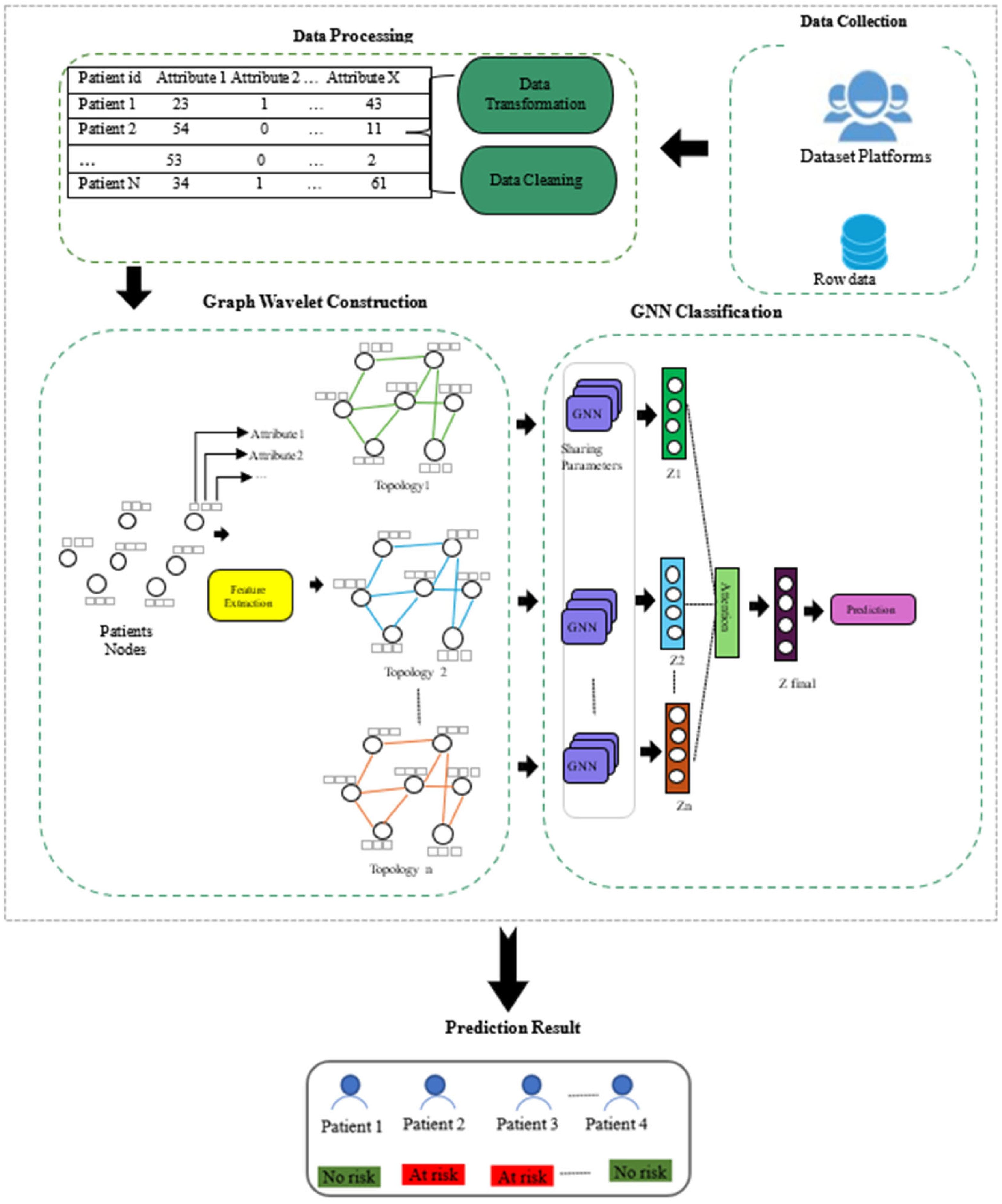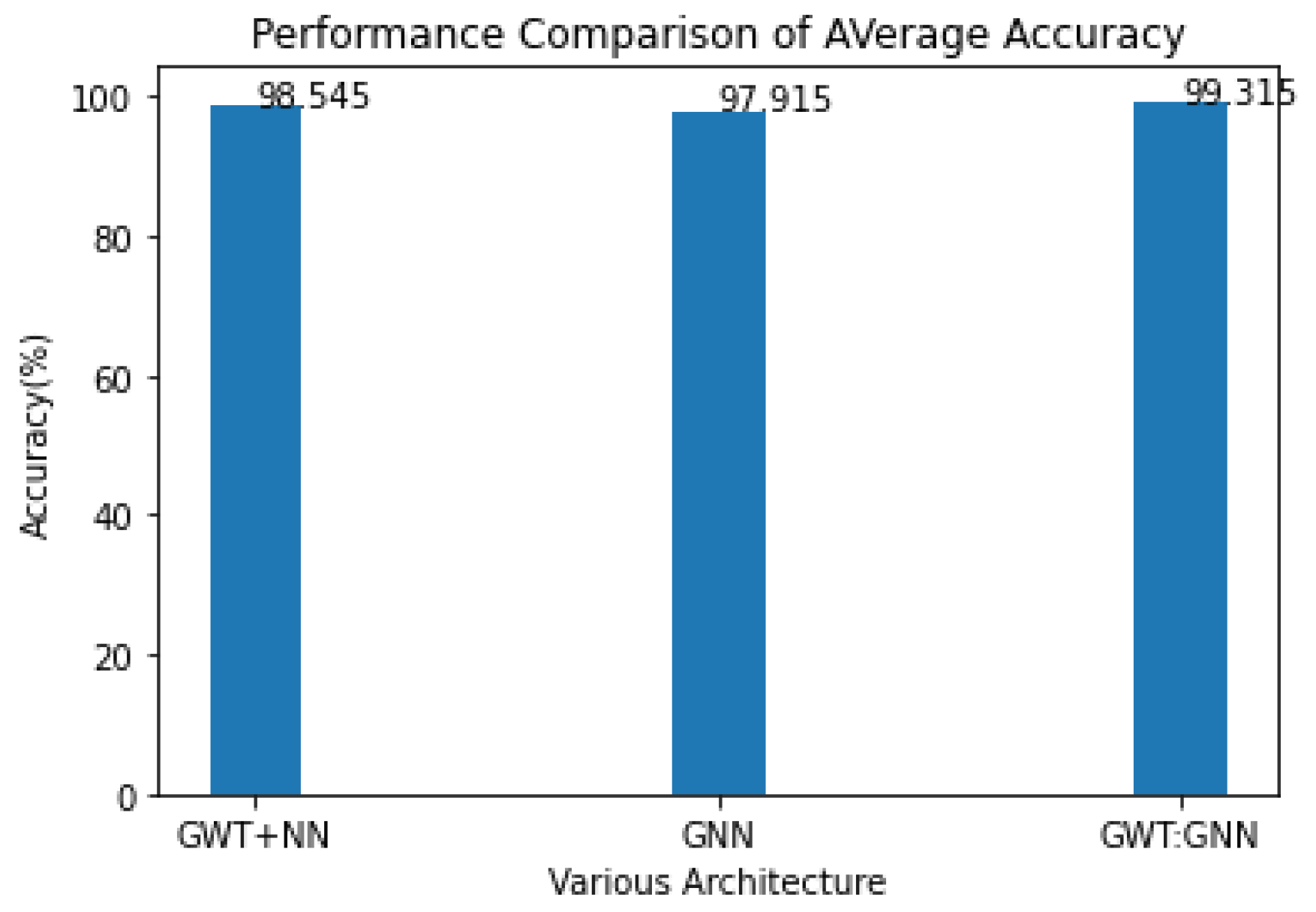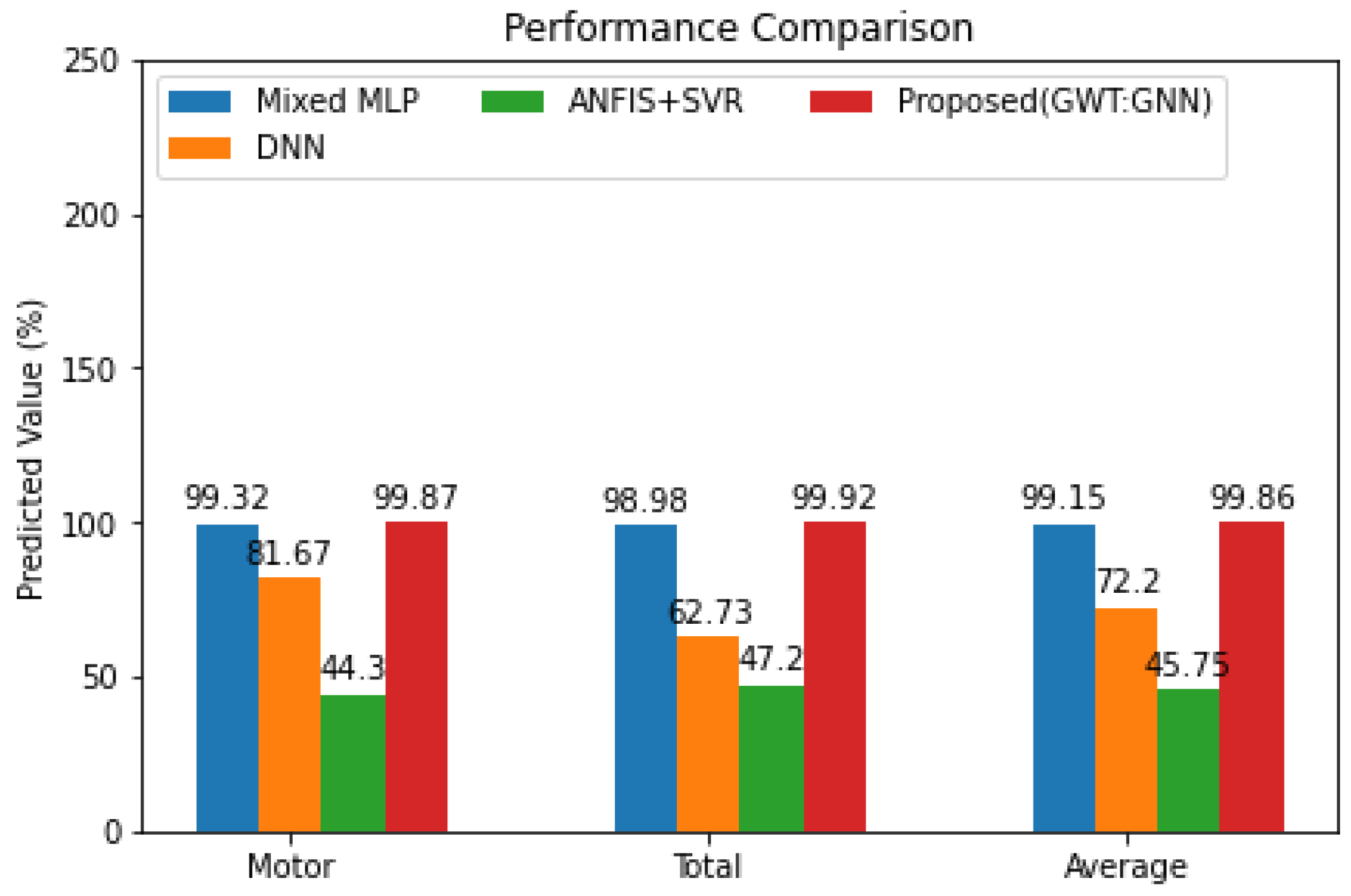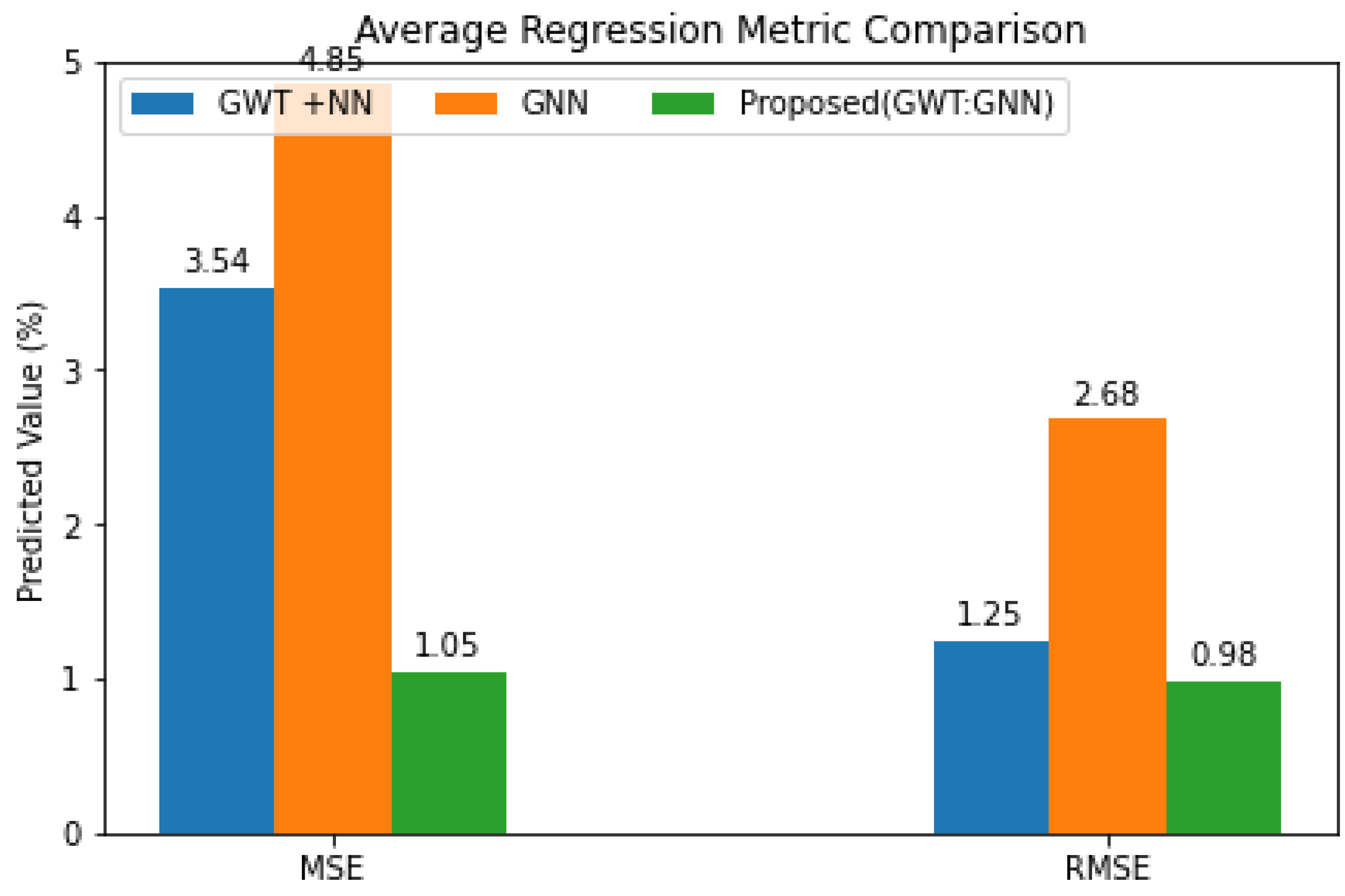Deep Learning for Parkinson’s Disease Diagnosis: A Graph Neural Network (GNN) Based Classification Approach with Graph Wavelet Transform (GWT) Using Protein–Peptide Datasets
Abstract
1. Introduction
2. Literature Survey
3. Materials and Methods
- Data Pre-processing
- Data Cleaning: Improving the quality of data requires cleaning it, which includes deduplicating, patching, correcting, or removing incomplete or inappropriate data.
- Data Transformation: Transferring information from one form to another is known as data transformation. Data transformation, including data size transformation and type transformation, is necessary when the original data type does not match the needs of the model input. Our approach requires numerical inputs to determine data similarity.
3.1. Graph Wavelet Transform
3.1.1. Creation of Weighted Graph
3.1.2. Feature Selection and Wavelet Transform
| Algorithm 1: Feature Similarity Calculation using GWT |
3.2. Graph Neural Network
- GNN Architecture
- (1)
- The first step in feature extraction is filtering. Different feature detection methods will use different filtering techniques on the input image. The Blur Filters system and the Edge Identification Filters are two of the filters.
- (2)
- The length of the (n × n) convolutional median filter is specified by the kernel length.
- (3)
- Activation—the capacity of a neuron to be triggered. A Rectifier Linear Unit (ReLU) value activates every layer except the output level. They have also added nonlinearity to the system using ReLU. It is essential for detecting linear correlations in feature mapping.
- (4)
- Nodes for Input: This layer has many streams and input images.
- GNN Training and Testing Procedure
- Training Steps:
- Remove the gradient
- Completed single forward pass
- Determine loss by using nodes for training
- Find the gradient and revise the settings as needed.
- Testing Steps:
- Expected class of nodes
- Retrieved class label with the highest possible
- Verified the number of accurately predicted values
- An accuracy ratio is made by dividing the total number of nodes by the sum of accurate predictions.
| Algorithm 2: GNN for Data Prediction |
4. Results
4.1. Dataset Description and Experimental Setup
4.2. Experimental Results
5. Conclusions and Future Work
Author Contributions
Funding
Institutional Review Board Statement
Informed Consent Statement
Data Availability Statement
Conflicts of Interest
References
- Alves, G.; Forsaa, E.B.; Pedersen, K.F.; Dreetz Gjerstad, M.; Larsen, J.P. Epidemiology of Parkinson’s disease. J. Neurol. 2008, 255 (Suppl. S5), 1832. [Google Scholar] [CrossRef] [PubMed]
- Kirsch, L.; Dane, S.; Adam, S.; Dardov, V. AMP®-Parkinson’s Disease Progression Prediction. Kaggle. 2023. Available online: https://kaggle.com/competitions/amp-parkinsons-disease-progression-prediction (accessed on 10 June 2008).
- de Deus Fonticoba, T.; Santos Garcia, D.; Macias Arribi, M. Inter-rater variability in motor function assessment in Parkinson’s disease between experts in movement disorders and nurses specialising in PD management. Neurologia 2019, 34, 520–526. [Google Scholar] [CrossRef] [PubMed]
- Post, B.; Merkus, M.P.; de Bie, R.M.A.; de Haan, R.J.; Speelman, J.D. Unified Parkinson’s disease rating scale motor examination: Are ratings of nurses, residents in neurology, and movement disorders specialists interchangeable? Mov. Disord. 2005, 20, 1577–1584. [Google Scholar] [CrossRef] [PubMed]
- Shawen, N.; O’brien, M.K.; Venkatesan, S.; Lonini, L.; Simuni, T.; Hamilton, J.L.; Ghaffari, R.; Rogers, J.A.; Jayaraman, A. Role of data measurement characteristics in the accurate detection of Parkinson’s disease symptoms using wearable sensors. J. Neuroeng. Rehabil. 2020, 17, 52. [Google Scholar] [CrossRef]
- Armstrong, M.J.; Okun, M.S. Diagnosis and treatment of Parkinson disease: A review. JAMA 2020, 323, 548–560. [Google Scholar] [CrossRef]
- Heijmans, M.; Habets, J.G.V.; Herff, C.; Aarts, J.; Stevens, A.; Kuijf, M.L.; Kubben, P.L. Monitoring Parkinson’s disease symptoms during daily life: A feasibility study. NPJ Park. Dis. 2019, 5, 21. [Google Scholar] [CrossRef]
- Goetz, C.G.; Tilley, B.C.; Shaftman, S.R.; Stebbins, G.T.; Fahn, S.; Martinez-Martin, P.; Poewe, W.; Sampaio, C.; Stern, M.B.; Dodel, R.; et al. Movement Disorder Society-sponsored revision of the Unified Parkinson’s Disease Rating Scale (MDS-UPDRS): Scale presentation and clinimetric testing results. Mov. Disord. 2008, 23, 2129–2170. [Google Scholar] [CrossRef] [PubMed]
- Guo, Y.; Stebbins, G.T.; Mestre, T.A.; Goetz, C.G.; Luo, S. Movement disorder society unified Parkinson’s disease rating scale motor examination retains its 2-domain profile in both on and off states. Mov. Disord. Clin. Pract. 2022, 9, 1149–1151. [Google Scholar] [CrossRef]
- Guo, Y.; Goetz, C.G.; Stebbins, G.T.; Mestre, T.A.; Luo, S. Using Movement Disorder Society Unified Parkinson’s Disease Rating Scale Parts 2 and 3 Simultaneously: Combining the Patient Voice with Clinician Ratings. Mov. Disord. 2023, 38, 453–463. [Google Scholar] [CrossRef] [PubMed]
- Nilashi, M.; Abumalloh, R.A.; Minaei-Bidgoli, B.; Samad, S.; Yousoof Ismail, M.; Alhargan, A.; Abdu Zogaan, W. Predicting parkinson’s disease progression: Evaluation of ensemble methods in machine learning. J. Healthc. Eng. 2022, 2022, 2793361. [Google Scholar] [CrossRef]
- Dar, M.N.; Akram, M.U.; Yuvaraj, R.; Khawaja, S.G.; Murugappan, M. EEG-based emotion charting for PD patients using Convolutional Recurrent NNs and cross dataset learning. Comput. Biol. Med. 2022, 144, 105327. [Google Scholar] [CrossRef] [PubMed]
- McCoy, L.G.; Brenna, C.T.; Chen, S.S.; Vold, K.; Das, S. Believing in black boxes: ML for healthcare does not need explainability to be evidence-based. J. Clin. Epidemiol. 2022, 142, 252–257. [Google Scholar] [CrossRef]
- Sivaranjini, S.; Sujatha, C.M. DL based diagnosis of PD using convolutional NN. Multimed. Tools Appl. 2020, 79, 15467–15479. [Google Scholar] [CrossRef]
- Shaban, M. Deep convolutional NN for PD based handwriting screening. In Proceedings of the 2020 IEEE 17th International Symposium on Biomedical Imaging Workshops (ISBI Workshops), Iowa City, IA, USA, 4 April 2020; pp. 1–4. [Google Scholar]
- Oh, S.L.; Hagiwara, Y.; Raghavendra, U.; Yuvaraj, R.; Arunkumar, N.; Murugappan, M.; Acharya, U.R. A DL approach for PD diagnosis from EEG signals. Neural Comput. Appl. 2020, 32, 10927–10933. [Google Scholar] [CrossRef]
- Davie, C.A. A review of Parkinson’s disease. Br. Med. Bull. 2008, 86, 109–127. [Google Scholar] [CrossRef] [PubMed]
- Gichoya, D.; Mdodo, K.L.; Rane, K. Magnetic Resonance Imaging in Antennas. Natl. J. Antennas Propag. 2024, 4, 28–33. [Google Scholar]
- Golmaei, S.N.; Luo, X. DeepNote-GNN: Predicting hospital readmission using clinical notes and patient network. In Proceedings of the 12th ACM Conference on Bioinformatics, Computational Biology, and Health Informatics, Gainesville, FL, USA, 1–4 August 2021; pp. 1–9. [Google Scholar]
- Yeh, W.C. A novel generalized artificial NN for mining two-class datasets. arXiv 2019, arXiv:1910.10461. [Google Scholar]
- Malathi, K. Preterm birth prognostic prediction using Cross domain data fusion. Int. J. Commun. Comput. Technol. (IJCCTS) 2019, 7, 10–13. [Google Scholar]
- Belic, M.; Bobic, V.; Badza, M.; Solaja, N.; Duric-Jovicic, M.; Kostic, V.S. Artificial intelligence for assisting diagnostics and assessment of Parkinson’s disease—A review. Clin. Neurol. Neurosurg. 2019, 184, 105442. [Google Scholar] [CrossRef] [PubMed]
- Shahid, A.H.; Singh, M.P. A deep learning approach for prediction of Parkinson’s disease progression. Biomed. Eng. Lett. 2020, 10, 227–239. [Google Scholar] [CrossRef] [PubMed]
- Yashir Ahamed, M.; Lalthlamuanpuii, R.; Chetia, B.; Awmi, L.; Chhakchhuak, L. Usage of Medical Library Resources: A Study in the Regional Institute of Medical Sciences, Imphal. Indian J. Inf. Sources Serv. 2023, 13, 1–6. [Google Scholar] [CrossRef]
- Boutet, A.; Madhavan, R.; Elias, G.J.B.; Joel, S.E.; Gramer, R.; Ranjan, M.; Paramanandam, V.; Xu, D.; Germann, J.; Loh, A.; et al. Predicting optimal deep brain stimulation parameters for Parkinson’s disease using functional MRI and machine learning. Nat. Commun. 2021, 12, 3043. [Google Scholar] [CrossRef]
- Rajesh, D.; Giji Kiruba, D.; Ramesh, D. Energy Proficient Secure Clustered Protocol in Mobile Wireless Sensor Network Utilizing Blue Brain Technology. Indian J. Inf. Sources Serv. 2023, 13, 30–38. [Google Scholar] [CrossRef]
- Harvey, J.; Reijnders, R.A.; Cavill, R.; Duits, A.; Kohler, S.; Eijssen, L.; Rutten, B.P.F.; Shireby, G.; Torkamani, A.; Creese, B.; et al. Machine learning-based prediction of cognitive outcomes in de novo Parkinson’s disease. NPJ Park. Dis. 2022, 8, 150. [Google Scholar] [CrossRef] [PubMed]
- Kim, J.; Kim, K.; Jeon, G.Y.; Sohn, M.M. Temporal Patterns Discovery of Evolving Graphs for Graph Neural Network (GNN)-based Anomaly Detection in Heterogeneous Networks. J. Internet Serv. Inf. Secur. 2022, 12, 72–82. [Google Scholar]
- Makarious, M.B.; Leonard, H.L.; Vitale, D.; Iwaki, H.; Sargent, L.; Dadu, A.; Violich, I.; Hutchins, E.; Saffo, D.; Bandres-Ciga, S.; et al. Multi-modality machine learning predicting Parkinson’s disease. NPJ Park. Dis. 2022, 8, 35. [Google Scholar] [CrossRef] [PubMed]
- Kumar, A.S.; Rekha, R. An improved hawks optimizer based learning algorithms for cardiovascular disease prediction. Biomed. Signal Process. Control 2023, 81, 104442. [Google Scholar] [CrossRef]
- Park, Y.H.; Suh, J.H.; Kim, Y.W.; Kang, D.R.; Shin, J.; Yang, S.N.; Yoon, S.Y. Machine learning based risk prediction for Parkinson’s disease with nationwide health screening data. Sci. Rep. 2022, 12, 19499. [Google Scholar] [CrossRef]
- Neduva, V.; Linding, R.; Su-Angrand, I.; Stark, A.; De Masi, F.; Gibson, T.J.; Lewis, J.; Serrano, L.; Russell, R.B. Systematic discovery of new recognition peptides mediating protein interaction networks. PLoS Biol. 2005, 3, e405. [Google Scholar] [CrossRef]
- Liu, D.; Angelova, A.; Liu, J.; Garamus, V.M.; Angelov, B.; Zhang, X.; Li, Y.; Feger, G.; Li, N.; Zou, A. Self-assembly of mitochondria-specific peptide amphiphiles amplifying lung cancer cell death through targeting the vdac1-hexokinase-ii complex. J. Mater. Chem. B 2019, 7, 4706–4716. [Google Scholar] [CrossRef] [PubMed]
- Mansouri, S. Application of Neural Networks in the Medical Field. J. Wirel. Mob. Netw. Ubiquitous Comput. Dependable Appl. 2023, 14, 69–81. [Google Scholar] [CrossRef]
- Lau, J.L.; Dunn, M.K. Therapeutic peptides: Historical perspectives, current development trends, and future directions. Bioorg. Med. Chem. 2018, 26, 2700–2707. [Google Scholar] [CrossRef] [PubMed]
- Malathi, K.; Shruthi, S.N.; Madhumitha, N.; Sreelakshmi, S.; Sathya, U.; Sangeetha, P.M. Medical Data Integration and Interoperability through Remote Monitoring of Healthcare Devices. J. Wirel. Mob. Netw. Ubiquitous Comput. Dependable Appl. (JoWUA) 2024, 15, 60–72. [Google Scholar] [CrossRef]
- Angelova, A.; Drechsler, M.; Garamus, V.M.; Angelov, B. Pep-lipid cubosomes and vesicles compartmentalized by micelles from self-assembly of multiple neuroprotective building blocks including a large peptide hormone pacap-dha. ChemNanoMat 2019, 5, 1381–1389. [Google Scholar] [CrossRef]
- Lee, A.C.-L.; Harris, J.L.; Khanna, K.K.; Hong, J.-H. A comprehensive review on current advances in peptide drug development and design. Int. J. Mol. Sci. 2019, 20, 2383. [Google Scholar] [CrossRef]
- Arora, G. Desing of VLSI Architecture for a flexible testbed of Artificial Neural Network for training and testing on FPGA. J. VLSI Circuits Syst. 2024, 6, 30–35. [Google Scholar]
- Vinogradov, A.A.; Yin, Y.; Suga, H. Macrocyclic peptides as drug candidates: Recent progress and remaining challenges. J. Am. Chem. Soc. 2019, 141, 4167–4181. [Google Scholar] [CrossRef]
- Jelena, T.; Srđan, K. Smart Mining: Joint Model for Parametrization of Coal Excavation Process Based on Artificial Neural Networks. Arch. Tech. Sci. 2023, 2, 11–22. [Google Scholar] [CrossRef]
- Pant, S.; Singh, M.; Ravichandiran, V.; Murty, U.; Srivastava, H.K. Peptide-like and small-molecule inhibitors against COVID-19. J. Biomol. Struct. Dyn. 2020, 39, 2904–2913. [Google Scholar] [CrossRef]
- Kumar, A.S.; Rekha, R. A Dense Network Approach with Gaussian Optimizer for Cardiovascular Disease Prediction. New Gener. Comput. 2023, 41, 859–878. [Google Scholar] [CrossRef]
- Tremblay, N.; Borgnat, P. Graph wavelets for multiscale community mining. IEEE Trans. Signal Process. 2014, 62, 5227–5239. [Google Scholar] [CrossRef]
- Tsanas, A.; Little, M.A.; Mcsharry, P.E.; Ramig, L.O. Accurate telemonitoring of Parkinson’s disease progression by non-invasive speech tests. Nat. Preced. 2010, 57, 884–893. [Google Scholar] [CrossRef]
- Tsanas, A.; Little, M.A.; Ramig, L.O. Remote assessment of Parkinson’s disease symptom severity using the simulated cellular mobile telephone network. IEEE Access 2021, 9, 11024–11036. [Google Scholar] [CrossRef] [PubMed]
- Xu, K.; Jegelka, S.; Hu, W.; Leskovec, J. How powerful are graph neural networks? In Proceedings of the 7th International Conference on Learning Representations, New Orleans, LA, USA, 6–9 May 2019. [Google Scholar]
- Martins, P.M.; Santos, L.H.; Mariano, D.; Queiroz, F.C.; Bastos, L.L.; de Gomes, I.S.; Fischer, P.H.C.; Rocha, R.E.O.; Silveira, S.A.; de Lima, L.H.F.; et al. Propedia: A database for protein–peptide identification based on a hybrid clustering algorithm. BMC Bioinform. 2021, 22, 1. [Google Scholar] [CrossRef] [PubMed]
- Nilashi, M.; Ibrahim, O.; Ahani, A. Accuracy improvement for predicting Parkinson’s disease progression. Sci. Rep. 2016, 6, 34181. [Google Scholar] [CrossRef] [PubMed]
- Grover, S.; Bhartia, S.; Akshama; Yadav, A.; Seeja, K.R. Predicting severity of Parkinson’s disease using deep learning. Procedia Comput. Sci. 2018, 132, 1788–1794. [Google Scholar] [CrossRef]
- García-Ordás, M.T.; Benítez-Andrades, J.A.; Aveleira-Mata, J.; Alija-Pérez, J.-M.; Benavides, C. Determining the severity of Parkinson’s disease in patients using a multi task neural network. Multimed. Tools Appl. 2024, 83, 6077–6092. [Google Scholar] [CrossRef]







| S.NO | Features |
|---|---|
| 1 | PDB |
| 2 | Protein Name |
| 3 | Resolution |
| 4 | Classification |
| 5 | Peptide Chain |
| 6 | Peptide Size |
| 7 | Peptide Sequence |
| 8 | Peptide Description |
| 9 | Peptide Organism |
| 10 | Peptide Interface Area |
| 11 | Peptide Molecular Weight |
| 12 | Peptide Aromaticity |
| 13 | Peptide Instability |
| 14 | Peptide Isoelectric Point |
| 15 | Receptor Chain |
| 16 | Receptor Size |
| 17 | Receptor Sequence |
| 18 | Receptor Description |
| 19 | Receptor Organism |
| 20 | Receptor Interface Area |
| 21 | Receptor Molecular Weight |
| 22 | Receptor Aromaticity |
| 23 | Receptor Instability |
| 24 | Receptor Isoelectric Point |
| 25 | Sequence Cluster |
| 26 | Is Sequence Cluster Centroid |
| 27 | Interface Cluster |
| 28 | Is Interface Cluster Centroid |
| 29 | Binding Cluster |
| 30 | Is Binding Cluster Centroid |
| Net | Motor (%) | Total (%) | Average (%) |
|---|---|---|---|
| GWT + NN | 98.41 | 98.68 | 98.545 |
| GNN | 97.26 | 98.57 | 97.915 |
| GWT + GNN | 99.79 | 98.84 | 99.315 |
| Net | MSE | RMSE |
|---|---|---|
| GWT + NN | 0.98542 | 0.9584 |
| GNN | 1.8542 | 1.3846 |
| GWT + GNN | 0.1458 | 0.2547 |
| Net | MSE | RMSE |
|---|---|---|
| GWT + NN | 0.8657 | 0.8864 |
| GNN | 1.8754 | 2.5842 |
| GWT + GNN | 0.1796 | 0.2845 |
| Net | MSE | RMSE |
|---|---|---|
| DWT + GNN | 0.2845 | 0.3572 |
| FT + GNN | 0.5487 | 0.4685 |
| GWT + GNN | 0.1796 | 0.2845 |
Disclaimer/Publisher’s Note: The statements, opinions and data contained in all publications are solely those of the individual author(s) and contributor(s) and not of MDPI and/or the editor(s). MDPI and/or the editor(s) disclaim responsibility for any injury to people or property resulting from any ideas, methods, instructions or products referred to in the content. |
© 2024 by the authors. Licensee MDPI, Basel, Switzerland. This article is an open access article distributed under the terms and conditions of the Creative Commons Attribution (CC BY) license (https://creativecommons.org/licenses/by/4.0/).
Share and Cite
Mohanraj, P.; Raman, V.; Ramanathan, S. Deep Learning for Parkinson’s Disease Diagnosis: A Graph Neural Network (GNN) Based Classification Approach with Graph Wavelet Transform (GWT) Using Protein–Peptide Datasets. Diagnostics 2024, 14, 2181. https://doi.org/10.3390/diagnostics14192181
Mohanraj P, Raman V, Ramanathan S. Deep Learning for Parkinson’s Disease Diagnosis: A Graph Neural Network (GNN) Based Classification Approach with Graph Wavelet Transform (GWT) Using Protein–Peptide Datasets. Diagnostics. 2024; 14(19):2181. https://doi.org/10.3390/diagnostics14192181
Chicago/Turabian StyleMohanraj, Prabhavathy, Valliappan Raman, and Saveeth Ramanathan. 2024. "Deep Learning for Parkinson’s Disease Diagnosis: A Graph Neural Network (GNN) Based Classification Approach with Graph Wavelet Transform (GWT) Using Protein–Peptide Datasets" Diagnostics 14, no. 19: 2181. https://doi.org/10.3390/diagnostics14192181
APA StyleMohanraj, P., Raman, V., & Ramanathan, S. (2024). Deep Learning for Parkinson’s Disease Diagnosis: A Graph Neural Network (GNN) Based Classification Approach with Graph Wavelet Transform (GWT) Using Protein–Peptide Datasets. Diagnostics, 14(19), 2181. https://doi.org/10.3390/diagnostics14192181





